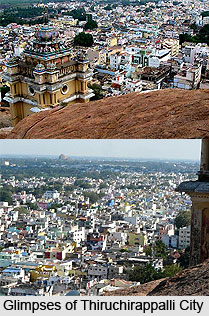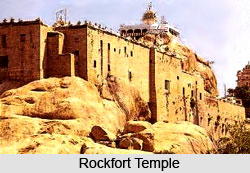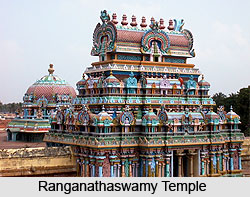 Tiruchirappalli is a city in the Tamil Nadu state of India and the administrative headquarters of Tiruchirappalli district. It is also called "Tiruchi" or "Trichy". At present, Thiruchirappalli is the fourth major city of Tamil Nadu and the headquarters of Trichy district. Owing to the presence of energy equipment manufacturing units in and around the city, it has earned the name of "Energy equipment and fabrication capital of India" Tiruchirappalli is also an important educational centre and houses nationally recognised institutions such as the Anna University, Indian Institute of Management (IIMT), Indian Institute of Information Technology (IIIT) National Institute of Technology (NITT) and Bharathidasan Institute of Management.
Tiruchirappalli is a city in the Tamil Nadu state of India and the administrative headquarters of Tiruchirappalli district. It is also called "Tiruchi" or "Trichy". At present, Thiruchirappalli is the fourth major city of Tamil Nadu and the headquarters of Trichy district. Owing to the presence of energy equipment manufacturing units in and around the city, it has earned the name of "Energy equipment and fabrication capital of India" Tiruchirappalli is also an important educational centre and houses nationally recognised institutions such as the Anna University, Indian Institute of Management (IIMT), Indian Institute of Information Technology (IIIT) National Institute of Technology (NITT) and Bharathidasan Institute of Management.
Location of Thiruchirappalli
It is located 322 kilometres south of Chennai and 379 kilometres north of Kanyakumari. The city sits almost at the geographic centre of the state. It lies on the plains between the Shevaroy Hills to the north and the Palni Hills to the south and south-west.
 Etymology of Thiruchirappalli
Etymology of Thiruchirappalli
The name of the place Thiruchirappalli is derived from its Jain association. It is known as the "rock fort city" of Tamil Nadu. In Tamil Nadu, Buddhism and Jainism flourished before the renaissance of Hinduism in the form of the Bhakti cult. The Bhakti cult popularized Saivism and Vaishnavism and exterminated these anti-Hindu religions in Thiruchirappalli. Therefore, several Jain and Buddhist traces can be found scattered in remote and unapproachable spots throughout Thiruchirappalli.
`Chira` was actually the name of a Jain monk and his `palli` or abode was once in this rock. Hence, it came to be known as Chirappalli. Later, Thiru was added to it as it is an adjective of reverence in the Tamil language. The beautiful name is now reduced to `Trichy` as nobody feels comfortable to pronounce its full name.
In Tamil grammar, there is a special rule for shortening names like this. This rule is called `Maruvu`. It was a famous place in the Sangam Age and the capital city of Cholas, called `Uraiyur` even before its association with Jains.
Demographics of Thiruchirappalli
On the basis of 2011 Indian census, Tiruchirappalli had a population of 847,387 of which 9.4% were under the age of six. The average literacy rate was 91.37%, significantly higher than the national average of 73.00%.
 Historical Significance of Thiruchirappalli
Historical Significance of Thiruchirappalli
This place has a historical significance in Tamil Nadu. The Cheras, the Cholas and the Pandyas have ruled in Thiruchirappalli. Thereafter, the Pallavas, the later Pandyas, the later Cholas, the Vijayanagar rulers, the Marathas, the Nawabs, the French and Finally the British came to rule this strategic place which is more or less centrally located place in Tamil Nadu.
Climate of Thiruchirappalli
The city is the hottest in the state. It experiences an annual mean temperature of 28.9 degree C and monthly average temperatures ranging between 25 degree C and 32 degree C. It faces frequent dust storms from April to June. From June to September, the city experiences a moderate climate tempered by heavy rain and thundershowers. Rainfall is heaviest between October and December because of the north-east monsoon winds, and from December to February the climate is cool and moist.
Economy of Thiruchirappalli
Tiruchirappalli is a major engineering equipment manufacturing and fabrication hub in India. Bharat Heavy Electricals Limited (BHEL), India`s largest public sector engineering company was set up in May 1965. Other important industries include Trichy Distilleries and Chemicals Limited (TDCL) and the Trichy Steel Rolling Mills. From the late 1980s, a synthetic gem industry was developed in the city. In 1990, the Indian government launched a scheme to increase employment by boosting the production of American diamonds and training local artisans in semi-automated machinery and technology. The local gem industry was reportedly generating annual revenues of INR100 million by the mid-1990s. The city also houses a number of retail and wholesale markets that serve the need of the people.
Monuments of Thiruchirappalli
This city is home to a number of ancient temples of archaeological importance including the Rockfort temples, the Ranganathaswamy temple, the Jambukeswarar temple, the Samayapuram Mariamman temple, the Erumbeeswarar temple, and Ukrakaliamman temple. All these temples exhibit the Dravidian style of architecture. The Ranganathaswamy temple and Jambukeswarar temple are often counted among the best examples of this style. The rock-cut cave temples of the Rockfort, along with the gateway and the Erumbeeswarar temple are listed as monuments of national significance by the Archaeological Survey of India.



















